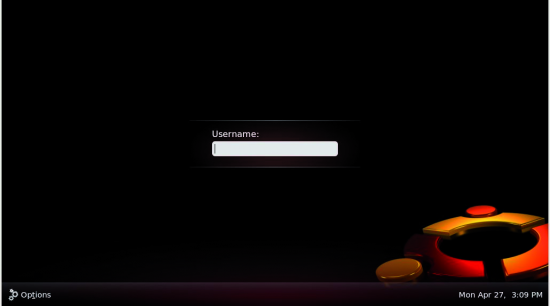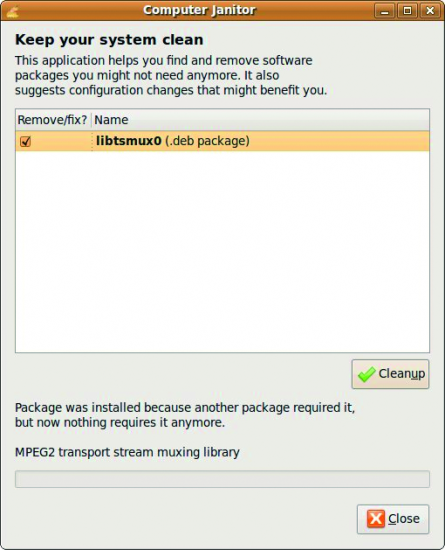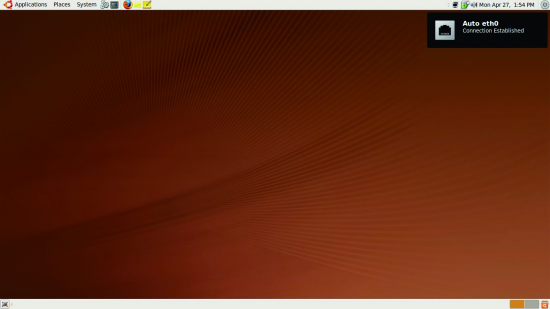It has not always been a bed of roses for Ubuntu, which has its share of brickbats. And yet, there is something about it that attracts users. It might be the simplicity of not having to decide between multiple editions of the same release. Ubuntu’s professional look and feel, coupled with its coherence, could be the reason. It might even be the simplified presentation of a network of technologies. Perhaps it’s a bit of all these attractions. Yet, love it or hate it, it remains one of the most popular distributions ever.
Personally, I use it because… well, I have mentioned enough reasons. And so, when version 9.04, the Jaunty Jackalope was released on April 23, I downloaded it the very same day and set about trying it on my new laptop. Here is an account of my (ongoing) experience with Jaunty.
The machine
My laptop, on which I installed Jaunty, is a Dell Inspiron 1545 with the following specs:
- Intel Core 2 Duo 2.0 GHz processor
- 3 GB RAM
- 320 GB SATA hard disk
- Integrated Intel graphics
- 15.6-inch (39.6 cm) wide screen with a native resolution of 1366×768
- 10/100 Mbps Ethernet port
- Bluetooth and Wi-Fi
- 1.3 mega-pixel Web cam
First impressions
I downloaded the 32-bit version of the live CD (which is bundled with this month’s LFY). Booting with the CD revealed the first difference from several preceding releases. The boot splash has changed, replacing the graduated progress bar with a thinner, colour-varied one. Next up, the GDM login screen has also changed, and so has the default wallpaper. Both now look much more professional than the previous ones.

The following is a list of the major goodies included this time:
- Linux 2.6.28
- GNOME 2.26.1
- Firefox 3.0.8
- OpenOffice.org 3.0.1
- ext4 file system support (the default is still ext3)
- Amazon EC2-compatible cloud computing support
- A version specially designed for net books
ext4 support is one of the major changes hitting distributions these days, but there are still occasional problems like data loss and lockups, so ext3 is the default. A technology called Eucalyptus allows you to set up a cloud computing facility, but it may not be ready for full-time use yet. This time, the Ubuntu team has also created a special version of the operating system for net books.
Apart from this, Brasero is also updated, and a tool called Computer Janitor is included, which is basically a system clean-up utility, capable of removing orphan packages, for instance. The Droid font set, originally designed for mobile devices, is now available as ttf-droid in the repositories. Its sans-serif version is very clean and nice looking. You may wish to try it out as your UI font.

All, however, is not well as far as my laptop is concerned. I found that the in-built Bluetooth device was recognised only if it was switched on before Ubuntu booted. Even then, if I switched it off while logged in, it was not recognised after switching it on again. My old USB Bluetooth device was recognised correctly, so I decided to use that instead and, finding all else to be working correctly, I started the installation from the boot screen after a reboot.
The installer started from the boot screen through the Install Ubuntu option, which now occupies the entire screen. The installer’s time zone selector has also been changed to a nice looking flat zonal map, which makes more sense for time zones than the earlier maps. The manual partitioner also allows you to select the ext4 file system if you want. Other than a cosmetic change in the keyboard layout selector, the rest of the installer is pretty much the same.
Inside the system
As I rebooted into the newly-installed system, I noticed that the boot-up time has also decreased, and going from boot screen to login to desktop is pretty quick.
After I had logged in to the installed system, I connected to the Internet to refresh the repository cache, and here I found the new notification system working as advertised in the technical overview on the Ubuntu website. Canonical has come up with a new system to notify users on matters like network connection status changes, print job status changes, new e-mails, etc. The default balloon tips no longer appear. They have been replaced by black rectangles appearing near the top right corner of the screen.

The software, called Notify OSD, has received a not-too-excited welcome from the community. Some say it is useless because its position cannot be changed and it cannot show timeout or button widgets like the balloons, while others say it will be fine only if the work goes upstream so that it is included in standard GNOME. On the other hand, most people do like its appearance and the fact that it does not create overlapping notifications. For me, it doesn’t matter that much as long as it works correctly.
The software update system now does not show the balloon tip informing of available updates, but launches the Update Manager directly if updates are available. I don’t know whether this has been done to prevent out-of-place notifications now that Notify OSD is being used, but the release notes say that you can restore the old behaviour by issuing the following command:
gconftool -s --type bool /apps/update-notifier/auto_launch false
Synaptic, the package manager, has also acquired the ability to show screenshots of programs, although many programs don’t have screenshots available.
On board, the rest is as usual. The stock software is included and the hardware is detected correctly, including my native screen resolution. My system does not have a separate graphics card, but the unobtrusive 3D effects of the user interface worked smoothly. Suspend/resume worked normally, and there were no freezes. Not finding any updates for my erratic Bluetooth device, however, I tried an alternative called Blueman (Bluetooth Manager), available through a Launchpad PPA (Canonical’s custom software packaging service). Its homepage is at blueman-project.org. It replaces bluez-gnome, GNOME’s default Bluetooth software, and is somewhat more feature-laden. However, it could do nothing for my in-built Bluetooth device, so I changed back to bluez-gnome.
You may try it as an alternative if you work with Bluetooth frequently. I settled for my old and trusty USB Bluetooth device. The problem with the in-built one seems to be at a lower level—the kernel perhaps. The problem did not occur in Ubuntu 8.10, but it does occur in Fedora 10.
After a couple of days, I tried the Computer Janitor and it showed me a package that could be removed because it had once satisfied a dependency but was no longer needed now. The Janitor is good to have around to clean up the system if you want to, but it is not likely to be used too frequently since this is GNU/Linux, and especially since this is Debian (I usually remove packages completely, including configuration files, when I uninstall something on Debian).
Good enough
Debian-based systems generally don’t depart from the quality levels their parent upholds. It needs to be seen in which direction Canonical’s innovations like Notify OSD will go, but on the whole, even in version 9.04, they have maintained their tradition of providing up-to-date, but stable software without show-stopper bugs. The codec installation for proprietary multimedia formats works as usual, except that, in addition to the flashplugin-nonfree package, which has transitioned to flashplugin-installer, an adobe-flashplugin package is now available for Adobe Flash. Since it is not clear which one should be installed, I selected adobe-flashplugin seeing that it is supported by Canonical, whereas the others are not.
Ubuntu has always been a distribution that’s meant to be free as well as suitable for daily, real-life use. It has no paid version carrying proprietary stuff or extra facilities. It does not force experimental features on users and is not a restrictive, special-purpose system. Of course, there is a place for each of these too, and innovation, especially, has been a defining characteristic of GNU/Linux. However, we need the likes of Ubuntu too. I believe it is the integral feel, stability and comprehensiveness of the system that makes Ubuntu viable as an operating system for day-to-day use. At least, all of this has been true of the Ubuntu releases till now. I don’t know what the next version, the Karmic Koala, will bring to the table (the newly planted Eucalyptus will hopefully be palatable to the Koala by the time he arrives ;-)). Until then, the Jackalope seems to be jaunty enough!











































































